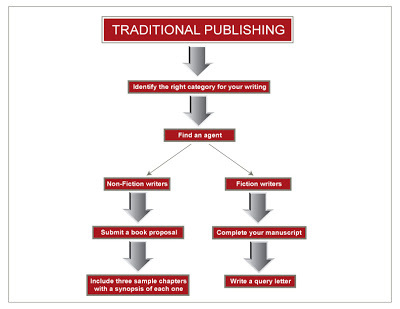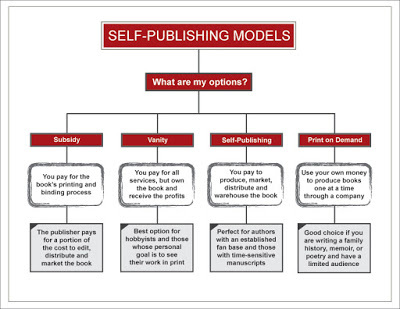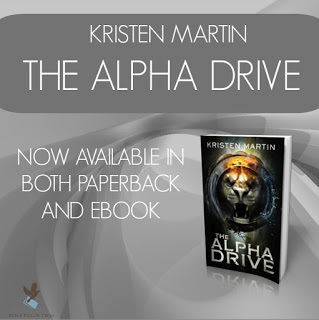How to Publish your Book
In previous posts, we've discussed how to find the inspiration to write, outlining and plotting your story, the importance of the first chapter, creating dynamic characters, crafting a satisfying climax, introducing crisis and calling, editing and reworking your novel, and preparing your MS for readers. Once you’ve done all of this, you’ll probably have a pretty-good looking story that is finally ready to be shown to the world? But wait… not yet. First, you have to decide whether you want to go the traditional publishing route or the self-publishing route. And that's what we'll be talking about today.
If you'd rather watch this video, feel free to click play below. If not, read on!
So what does it mean to be traditionally published? To be self-published? Let's define the two. Traditional publishing is when an aspiring author seeks out a literary agent, who then works with publishers on the author’s behalf. If all goes well, a publisher will offer the author a contract and in turn, print, publish, and sell your book through booksellers and other retailers. The publisher essentially buys the right to publish your book and pays you royalties from the sales. In self-publishing, the majority of the work falls on the author's shoulders where you pay for all expenses upfront. The main advantages of self-publishing are that you control when the book is published, you retain all rights to your book, and you receive 100 percent of the profits.
So how do you know which one is right for you? You need to do your research.
Here are some steps you would take if you wanted to traditionally publish your book:

If you want to publish a book traditionally, most writers need to find an agent. In order to find one, you must identify the right category for your writing. If you are or want to be a nonfiction writer, you will need to submit a book proposal with three sample chapters, and a synopsis of each chapter. If you are writing fiction, you must have your manuscript complete.
Once these steps are accomplished, you're ready to write a query letter. This letter is what you will send to potential agents. It's important to mention the different parts that make up a query letter. You should be sure to mention the synopsis of your book, the chapter summary, the market or audience your book is meant for, and a description of yourself.
That's traditional publishing in a nutshell.
Let's move on to self-publishing. There are a variety of different publishing models to take into consideration, including print-on-demand, vanity, subsidy, and self-publishing.

Print-on-demand (POD) publishers accept all submissions and anyone who is willing to pay is published. POD publishing uses printing technology to produce books one at a time through a company at a cost-effective price. The books are printed individually as orders come in. Therefore, you can adjust the book's supply to meet the reader's demand. POD cuts back on costs and eliminates the need for space to store unsold copies. Typically editing, proofreading, or marketing is offered at an additional cost and you make money off of royalties from sales. In terms of rights, some can go to the POD publisher for a set amount of time but this varies depending on the publisher.
A vanity publisher, also known as a book manufacturer, publishes any anyone's work provided they have the money to pay for their services. The manufacturer prints and binds a book on the author's dime and does not offer editing, marketing, or promotional assistance. However, the author owns the printed books and retains all profit from sales.
A subsidy publisher is similar to a vanity publisher in that the author has to pay for the printing and binding process of the book. However, this type of publisher contributes a portion of the cost to editing, distribution, warehousing, and marketing. In this case, the publisher owns the books until they are sold and the author makes money from royalties.
Self-publishing requires the author to invest their own money to produce, market, distribute, and warehouse the book. While this can be a huge time commitment, the process can be more cost-effective than vanity or subsidy publishing.
Still having a hard time deciding? It’s okay. It’s a big decision. Let me lay out the pros and cons of each route:
Pros of Traditional Publishing
• Wide distribution and more exposure
• Most offer an advance, sometimes a large one
• They do the editing, formatting, cover art
• Marketing power
Cons of Traditional Publishing
• Take six to eighteen months before publication
• Ebooks are priced high
• They have power over cover art and title
• Don’t use the marketing power they wield effectively
• Pay royalties twice a year
• Don’t involve you in many of the decisions regarding your book
• Difficult to implement changes
• Lousy royalty rates, between 6% and 25%
• Very hard to break into
Pros of Self-Publishing
• Paid once a month
• You control price and cover
• Publication is almost instant
• Easy to implement changes
• Every decision is yours
• Great royalty rates
• Anyone can do it
Cons of Self-Publishing
• No free professional editing, formatting, or cover art
• Fewer sales
• Greater potential to publish crappy books
There you have it, your guide to traditionally publish or self-publish your bookbaby. I hope this post was helpful. As long as you do your research, you should be just fine. If you have any questions, feel free to comment down below, or go to my Ask Me Anything page on Tumblr.
[source]

Until next time,

If you'd rather watch this video, feel free to click play below. If not, read on!
So what does it mean to be traditionally published? To be self-published? Let's define the two. Traditional publishing is when an aspiring author seeks out a literary agent, who then works with publishers on the author’s behalf. If all goes well, a publisher will offer the author a contract and in turn, print, publish, and sell your book through booksellers and other retailers. The publisher essentially buys the right to publish your book and pays you royalties from the sales. In self-publishing, the majority of the work falls on the author's shoulders where you pay for all expenses upfront. The main advantages of self-publishing are that you control when the book is published, you retain all rights to your book, and you receive 100 percent of the profits.
So how do you know which one is right for you? You need to do your research.
Here are some steps you would take if you wanted to traditionally publish your book:

If you want to publish a book traditionally, most writers need to find an agent. In order to find one, you must identify the right category for your writing. If you are or want to be a nonfiction writer, you will need to submit a book proposal with three sample chapters, and a synopsis of each chapter. If you are writing fiction, you must have your manuscript complete.
Once these steps are accomplished, you're ready to write a query letter. This letter is what you will send to potential agents. It's important to mention the different parts that make up a query letter. You should be sure to mention the synopsis of your book, the chapter summary, the market or audience your book is meant for, and a description of yourself.
That's traditional publishing in a nutshell.
Let's move on to self-publishing. There are a variety of different publishing models to take into consideration, including print-on-demand, vanity, subsidy, and self-publishing.

Print-on-demand (POD) publishers accept all submissions and anyone who is willing to pay is published. POD publishing uses printing technology to produce books one at a time through a company at a cost-effective price. The books are printed individually as orders come in. Therefore, you can adjust the book's supply to meet the reader's demand. POD cuts back on costs and eliminates the need for space to store unsold copies. Typically editing, proofreading, or marketing is offered at an additional cost and you make money off of royalties from sales. In terms of rights, some can go to the POD publisher for a set amount of time but this varies depending on the publisher.
A vanity publisher, also known as a book manufacturer, publishes any anyone's work provided they have the money to pay for their services. The manufacturer prints and binds a book on the author's dime and does not offer editing, marketing, or promotional assistance. However, the author owns the printed books and retains all profit from sales.
A subsidy publisher is similar to a vanity publisher in that the author has to pay for the printing and binding process of the book. However, this type of publisher contributes a portion of the cost to editing, distribution, warehousing, and marketing. In this case, the publisher owns the books until they are sold and the author makes money from royalties.
Self-publishing requires the author to invest their own money to produce, market, distribute, and warehouse the book. While this can be a huge time commitment, the process can be more cost-effective than vanity or subsidy publishing.
Still having a hard time deciding? It’s okay. It’s a big decision. Let me lay out the pros and cons of each route:
Pros of Traditional Publishing
• Wide distribution and more exposure
• Most offer an advance, sometimes a large one
• They do the editing, formatting, cover art
• Marketing power
Cons of Traditional Publishing
• Take six to eighteen months before publication
• Ebooks are priced high
• They have power over cover art and title
• Don’t use the marketing power they wield effectively
• Pay royalties twice a year
• Don’t involve you in many of the decisions regarding your book
• Difficult to implement changes
• Lousy royalty rates, between 6% and 25%
• Very hard to break into
Pros of Self-Publishing
• Paid once a month
• You control price and cover
• Publication is almost instant
• Easy to implement changes
• Every decision is yours
• Great royalty rates
• Anyone can do it
Cons of Self-Publishing
• No free professional editing, formatting, or cover art
• Fewer sales
• Greater potential to publish crappy books
There you have it, your guide to traditionally publish or self-publish your bookbaby. I hope this post was helpful. As long as you do your research, you should be just fine. If you have any questions, feel free to comment down below, or go to my Ask Me Anything page on Tumblr.
[source]

Until next time,

Published on March 22, 2016 17:47
No comments have been added yet.



